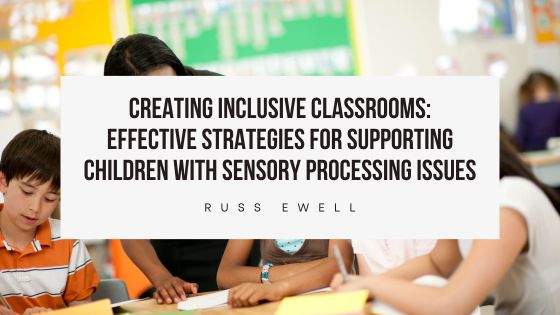In an inclusive classroom, every child feels valued and supported, regardless of their learning needs. An inclusive environment can make a world of difference for children with sensory processing issues. Sensory processing issues affect how the brain interprets and responds to sensory information, such as sounds, textures, lights, and movement. Some children may be susceptible to certain stimuli, while others may require more intense sensory input to focus or feel calm. Educators can help children with sensory processing challenges thrive in the classroom by implementing thoughtful strategies.
1. Create a Sensory-Friendly Environment
A sensory-friendly classroom environment can help children feel calm and focused. Small adjustments, like reducing bright lighting or managing noise levels, can make a big difference. Using softer lighting instead of fluorescent lights can help prevent overstimulation. Similarly, creating quiet spaces within the classroom allows children to retreat and regroup if they start feeling overwhelmed.
Noise-canceling headphones or earplugs can also be helpful for children who are sensitive to sound, while textured cushions or fidget tools can provide grounding for those who seek tactile input. By adapting the classroom environment to reduce sensory overload, teachers create a safer and more inclusive space for all students.
2. Establish Clear Routines and Transitions
Predictable routines are essential for children with sensory processing issues, as sudden changes can be difficult to process. A consistent daily schedule provides security and helps children understand what to expect. Visual schedules, which include pictures and symbols, can be particularly helpful in making routines clear and accessible.
Transitions between activities can be challenging for children with sensory needs. Signaling upcoming transitions with timers, verbal cues, or songs gives children a moment to mentally prepare. Teachers create a calming rhythm that helps children stay grounded by giving them a clear, predictable structure.
3. Use Sensory Breaks to Support Regulation
Sensory breaks are short periods of time during which children can engage in sensory activities that help them refocus. These breaks can include activities like jumping, stretching, or deep-breathing exercises. For more sensitive children, a sensory break might involve sitting in a quiet corner with a weighted blanket or engaging in calming activities like coloring or reading.
Designing a “sensory corner” or “calm down corner” in the classroom provides a designated space for children to take these breaks without disrupting others. Allowing children to access this space when they need it promotes self-regulation and helps them return to tasks with a clearer, calmer mind.
4. Incorporate Multisensory Teaching Methods
Multisensory teaching methods can help children with sensory processing issues engage with lessons more effectively. Pairing visual aids with spoken instructions can reinforce comprehension. Similarly, using manipulatives, like blocks for math problems or textured letters for reading activities, allows children to engage more than one sense, improving focus and retention.
Movement-based learning, such as incorporating hand gestures or physical activities into lessons, also helps children with sensory needs stay engaged. By offering multiple ways to interact with content, teachers make learning more accessible and enjoyable for all students.
5. Foster a Supportive Classroom Culture
Creating an inclusive classroom goes beyond environment and tools; it’s also about fostering empathy and understanding among peers. Educating the class on sensory processing issues, perhaps through age-appropriate stories or activities, helps children understand and respect each other’s differences. Encouraging open conversations about individual needs and strengths can foster a more supportive and compassionate classroom culture.
Additionally, working with parents and specialists can provide teachers with valuable insights into each child’s unique needs. Consistent communication between home and school ensures that strategies used in the classroom align with those used at home, creating a more cohesive approach to support.
Final Thoughts
Supporting children with sensory processing issues in the classroom is not only about helping them succeed academically; it’s about nurturing an environment where they feel seen, understood, and valued. By creating sensory-friendly spaces, establishing routines, using sensory breaks, incorporating multisensory teaching, and fostering an inclusive culture, educators can positively impact every child’s learning journey. Inclusive classrooms benefit all students, creating a community that celebrates differences and encourages growth together.

